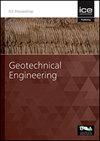结构粘土的离散元法建模
IF 1.7
4区 工程技术
Q3 ENGINEERING, GEOLOGICAL
Proceedings of the Institution of Civil Engineers-Geotechnical Engineering
Pub Date : 2023-03-16
DOI:10.1680/jgeen.22.00224
引用次数: 0
摘要
黏土中的结构是扰动作用下导致地基软弱和破坏的重要因素,其主要原因是颗粒间的胶结作用。现有的本构模型从现象学角度反映了粘土的破坏特征,而从微观角度来看,粘土损伤的机理尚不清楚。本研究采用离散元法,结合分别用于捕捉软黏土黏聚力和结构的黏结和黏结接触模型,对软黏土的胶结过程进行再现,建立了限压试验、叶片剪切试验和三轴试验的数值模型,旨在揭示软黏土结构对其变形破坏过程的影响。结果表明,在宏观上,变形和应力应变发展与实验结果吻合较好。建立了结构破坏与宏观力学行为之间的关系,有助于更好地揭示结构粘土的破坏机理。在此基础上,对叶片剪切试验中常规剪切应力计算方法提出了优化建议。本研究方法具有模拟结构粘土力学行为的潜力,对改进结构粘土的本构模型和工程设计具有重要意义。本文章由计算机程序翻译,如有差异,请以英文原文为准。
Discrete element method modeling of structural clay
Structures in clay, found as an important role resulting in the weakness and failure of foundations under disturbance, are mainly caused by the cementation between particles. Existing constitutive models reflect the failure characteristics of clay from the phenomenological aspect, while the mechanism of the clay damage from a microscopic perspective is still unclear. In this study, the discrete element method, together with the bond and cohesive contact model, which were introduced for capturing the cohesion and structure of soft clay, respectively, is used to reproduce the cementation of clay, the numerical models of confined compression test, vane shear test and triaxial test were established, aiming to reveal the influence of structure of clay on its deformation and failure process. The results exhibited that the deformation and stress-strain development were in good agreement with experimental results in macroscopic. Moreover, the relationship between the structural failure and the macroscopic mechanical behavior can be established, which is helpful to better uncover the failure mechanism of structural clay. According to this developed of failure surface under the micro scale, an optimized suggestions were proposed for the conventional shear stress calculation in the vane shear test. The method in this study has the potential to simulate the mechanical behavior of structural clay and how significant implications for the improvement of the constitutive models and engineering design.
求助全文
通过发布文献求助,成功后即可免费获取论文全文。
去求助
来源期刊
CiteScore
4.40
自引率
4.50%
发文量
68
审稿时长
3 months
期刊介绍:
Geotechnical Engineering provides a forum for the publication of high quality, topical and relevant technical papers covering all aspects of geotechnical research, design, construction and performance. The journal aims to be of interest to those civil, structural or geotechnical engineering practitioners wishing to develop a greater understanding of the influence of geotechnics on the built environment.

 求助内容:
求助内容: 应助结果提醒方式:
应助结果提醒方式:


